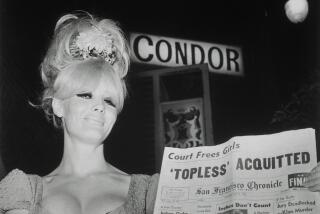When the sirens ruled the screens
- Share via
THOUGH actresses have long lamented the lack of good roles in feature films, back in the 1920s, ‘30s and ‘40s, it was definitely a woman’s world.
That was especially true in the Roaring ‘20s, which were filled with films that revolved around women. “How many movies do we have like that today?” asks film historian Cari Beauchamp. “We had Lillian Gish in ‘The Scarlet Letter’ and ‘La Boheme.’ We had Garbo in ‘A Woman of Affairs’ and Mary Pickford. We have Gloria Swanson in ‘Sadie Thompson.’ We have a full panoply of women’s roles.”
The ‘20s also saw the rise of the “siren” female lead -- exotic, alluring actresses who pushed the boundaries of screen censorship and sparked changes in contemporary culture -- thousands of women, for example, adopted Clara Bow’s short bob and kewpie-doll lipstick after she made “It” in 1927.
The UCLA Hammer Museum revisits the era with “The Female of the Species: Screen Sirens of the ‘20s” Friday nights at the Hammer Courtyard. Janet Klein and her Parlour Boys, alternating with music by theremin maestro Sukho Lee, will provide live music.
The series, inspired by the Hammer exhibition “The Societe Anonyme,” began this month, and Asian American actress Anna May Wong stars Friday in the recently restored 1929 British drama “Piccadilly,” directed by E.A. Dupont.
The next installment of the program features the flamboyant Russian actress Alla Nazimova in the surreal 1923 version of “Salome,” which was considered scandalous and a major box-office dud.
Screening Aug. 4 is “It,” in which Bow plays a department store salesgirl with plenty of it -- sex appeal.
The siren rounding out the festival is the least known because she never worked in America -- Brigitte Helm, who, in Fritz Lang’s 1927 “Metropolis,” has her beatific face transferred into that of a robot.
These films attracted both the male and female sexes, says Beauchamp. “[Irving] Thalberg said a woman can get a man to see a movie, but a man can’t get a woman to see a movie. Everybody was going to the movies then. People would go to the movies two or three times a week.”
And these films introduced rural America to the post-World War I world.
“This is when you don’t have television and other things we are so used to now,” Beauchamp says. “And this is where people for the first time, particularly outside the big cities, are seeing the world. They are seeing fashions and hair styles and mode of transportation. They are being taken away into a fantasy world.”
Being labeled a “siren” back then didn’t mean these actresses were interchangeable.
“You think of sirens and you have slotted them in one role. But not only are each of these roles different, each of the women is very different. Each had different careers. Nobody would wink like Clara Bow. Nazimova is a book unto herself but wonderful -- fabulous. Louise [Brooks] is another classic.
And, adds Beauchamp, “all of these women, in their own way both as actresses and in their roles, were pushing the envelopes. Remember, we had only left the Victorian era not that many decades before.”
*
The Female of the Species: Screen Sirens of the ‘20s
Where: Hammer Courtyard, Hammer Museum, 10899 Wilshire Blvd.
When: Fridays through Aug. 11 at 8 p.m.
Price: Free
Contact: (310) 443-7000 or www.hammer.ucla.edu/programs/52/
Schedule
Friday: “Piccadilly”
July 28: “Salome”
Aug. 4: “It”
Aug. 11: “Metropolis”
More to Read
Only good movies
Get the Indie Focus newsletter, Mark Olsen's weekly guide to the world of cinema.
You may occasionally receive promotional content from the Los Angeles Times.











